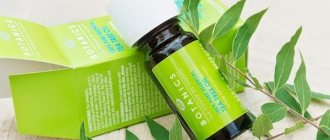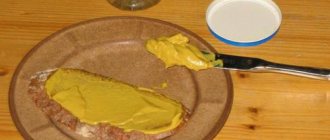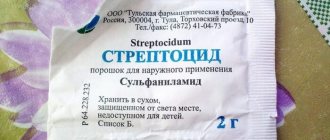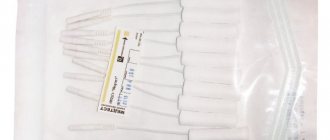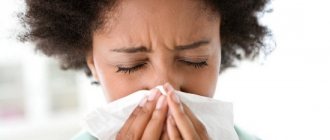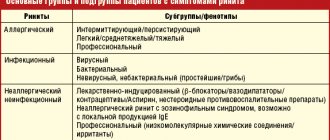There are no absolutely healthy people - every person has had a cold at least once in their life. And everyone approaches treatment differently: some trust only proven medications, while others prefer natural remedies. Everyone knows that long-term and frequent use of medications weakens the immune system, and some natural products, such as essential oils, on the contrary, help strengthen it. So how can you fight colds with ethers?
Essential oils for colds: how they work
Essential oil therapy is not only an easy, but also a pleasant way to combat viral and bacterial infections. Despite their aggressiveness towards microbes, they are absolutely harmless to humans. Esters create a special environment unsuitable for the life of pathogenic microorganisms. In addition, concentrated oils accelerate the penetration of antibiotics into human cells, increasing their effect several times.
Aromatherapy is a very pleasant way to combat viral infections
Video: how essential oils protect against colds
The effectiveness of tea tree oil for colds
The tea tree, or more precisely, a group of shrubs and trees with the common name “melaleuca,” grows in Malaysia, Australia and belongs to the myrtle family. Plants in this group can be grown wild or cultivated, while varieties grown with human assistance can reach impressive sizes. As a medicine, melaleuca has been used for a long time, and in the countries where the plant comes from, it is generally an obligatory component of the home medicine cabinet.
The essential oil obtained from the tea tree contains diterpenes, monoterpenes (including the antiviral substance viridofloren), as well as cineole, the main antiseptic component, which determines such a powerful therapeutic effect. Since too high a cineole content can provoke irritation and allergic reactions, this indicator in the final product is strictly controlled. Often, to normalize the composition of the oil, essential oils of tea tree subtypes are added to it - manuka and kanuka, which also have antiviral and antibacterial properties.
Thus, the most important quality of the product is its ability to fight viruses, microbes and fungi, which is very popular during colds. Therefore, after topical application of tea tree oil, the severity of inflammation decreases. No less significant is the property of aroma oil to stimulate the functioning of the immune system, due to which recovery is accelerated, that is, the cold disappears within a minimum period. This is due to the fact that when the product gets on the mucous membranes, it can activate the activity of leukocytes, which creates a “barrier” for microbes and viruses and prevents them from destroying healthy cells.
This healing product has other qualities that will be literally irreplaceable for a cold. The oil helps restore normal sleep, calms the nervous system, and also quickly increases performance, reduces intoxication, and eliminates symptoms of fatigue and weakness. All these qualities can serve both during the entire period of a cold and after recovery, when the body is still weakened by the infection. Among other things, the aroma oil will soften the nose after instillation, help wounds and cracks in the mucous membrane heal faster, prevent the skin under the nose from hurting and peeling, eliminate itching, reduce sneezing and tone the nasal vessels. Tea tree oil will prevent the disease from becoming chronic, therefore, thanks to all of the above, it is widely recommended in folk and traditional medicine.
Watch a video about the properties of tea tree essential oil and its use
Treatment of ailments and their symptoms
Each name of ether has an individual set of useful properties, but they can still be divided into subgroups according to the main directions of action:
- antipyretics: eucalyptus, lavender, chamomile, lemon balm, lemon, bergamot, mint;
- anti-inflammatory: chamomile, sage, thyme, cloves, tea tree, juniper, myrtle, grapefruit;
- antiviral: lemon, lavender, pine, fir, juniper, sage, tea tree, eucalyptus;
- immunostimulating and restorative: lavender, chamomile, tea tree, sage, rose, eucalyptus, ylang-ylang, juniper.
It is possible to use either one name of oil or a combination of several options. However, mixing more than three flavors is not advisable.
Due to the fact that essential oils are a highly concentrated product, treatment should begin with small doses: for the first time it is better to limit yourself to two drops.
Cough
Essential oils help fight infection, weaken bronchial spasms, thin mucus and remove it from the respiratory tract. But before you choose the right aroma, you need to determine the nature of the cough:
- when dry, esters of eucalyptus, coniferous trees (pine, fir, spruce), juniper, sandalwood, bergamot, ginger, cypress, lavender, chamomile, tea tree will be effective;
- against a wet cough accompanied by sputum production, preference should be given to basil, bergamot, lemon balm, peppermint, marjoram, rosemary, sandalwood, tea tree, fennel, thyme, sage, eucalyptus.
Some esters have a complex effect, helping with any type of cough.
Esters can be used to treat cough in different ways. But any of them effectively fights the symptom of the disease and strengthens the condition of the body as a whole.
Inhalations
Inhalations are done in two ways: cold and hot. For cold procedures, a nebulizer is used: a couple of drops of a certain ether are added to a saline solution, the vapors of which are deeply inhaled through the mouth. The procedure lasts about 20 minutes, the course of treatment is 7–10 days. If you don’t have this device, you can get by with a simpler option: soak a handkerchief in two drops of oil and breathe in the smell emanating from it for several minutes.
Cold inhalation procedures are performed using a nebulizer
The hot method is more common. It can be used without special units:
- Boil a liter of water and add the selected oil ensemble (or one name of ether) into it in the amount of two to five drops.
- Cool the boiling water slightly to avoid burning the respiratory tract.
- Bend over a bowl of liquid, covering your head with a towel and closing your eyes, and breathe in the aromatic vapors with your mouth for five to seven minutes.
Coughing occurs after the second procedure. But there is no need to stop: continue treatment for at least a week in the morning and evening until the symptom disappears.
When inhaling, you should inhale aromatic vapors with your eyes closed, covered with a towel.
Aromatherapy
Aromatherapy is recommended in the treatment of mild forms of the disease. During the session, essential aromas fill the entire space, preventing viruses from spreading. The procedure uses an aroma lamp, which should work for at least 30 minutes, but not exceeding two hours. Such sessions can be carried out all day, but with a break of at least 3 hours. The course of treatment is 5–7 days.
During an aromatherapy session, ethers fill the entire room, preventing the spread of pathogenic bacteria
If you don’t have a special unit, you can fill a small bowl with slightly cooled boiling water, diluting it with a drop of the chosen oil.
The most suitable concentrate for aromatherapy is eucalyptus essential oil.
Water treatments
Having a normal body temperature, it is good to take aromatic water procedures: mix 5-6 drops of ether (or several aromas) with sea salt (half a glass) and pour into a full warm bath. Relax and lie down for 15 minutes, ending the session with a warm bed.
Essential oils must be dissolved in an emulsifier before adding to water.
Massage
Rubbing the chest and back with a specially prepared massage mixture is an effective addition to medication for cough relief. To prepare a massage product, just add a couple of drops of concentrated aroma to any oil base (for example, olive oil). The session lasts 10 minutes and should be repeated daily for 7–10 days.
For massage during cough therapy, it is recommended to choose fir oil.
Rubbing a mixture of essential oils onto the back and chest area is an effective addition to the treatment of coughs.
Doctors often prescribe warm compresses. To do this, the mixture described above must be applied to a warm base (potatoes boiled in their jackets, honey, cabbage leaves) and applied to the chest on both sides, bypassing the heart, for half an hour. The recommended course of treatment is 7–10 days.
Runny nose
Fighting a runny nose with the help of ethers is an excellent solution to the problem, which provides a high therapeutic effect and has no negative consequences or contraindications (except for individual intolerance). In this case, you should purchase the following names of esters:
- tea tree;
- eucalyptus;
- fir;
- thuja;
- thyme.
These natural remedies can be used in different ways.
Nasal drops
To apply nasal drops, you need to combine two drops of the selected aroma with half a teaspoon of vegetable olive oil. 1/4 pipette of the oil product should be inserted into each nasal passage, after which you should lie on your back for several minutes. Do about 5 instillations per day until the symptom disappears.
In the absence of strong discharge, it is enough to lubricate the skin near the nostrils with tea tree ether. This concentrate has a high level of effectiveness, it is able to resist even antibiotic-resistant microorganisms.
Washing
To rinse the nose, you will need to brew 400 ml of chamomile or sage decoction, add 3-4 drops of ether (for example, thuja) to it and mix well. Rinse the nasal passages with this solution several times a day until the symptoms alleviate.
When green or yellow mucus is secreted, you need to prepare a slightly different solution for washing: dilute half a tablespoon of sea salt with a whole spoonful of warm water, drop a couple of drops of eucalyptus ether, and then dilute all this in 100 ml of chlorophyllipt. Use the liquid up to 4 times a day for a week.
Inhaling aromas
When eliminating a runny nose, additional methods of therapy such as inhalation and aromatherapy are often prescribed. These procedures are similar to those described above, but with the addition of aromas that correspond to this ailment. And with one more nuance - you need to inhale the vapors through your nose.
For sinusitis, warm inhalations with ethers of rosemary, thyme and mint in a ratio of 2:1:1 will be effective. These 4 drops should be added to a liter of moderately hot boiled water and the vapors should be breathed through the nose for about twenty minutes. The course of treatment is 10 procedures.
You cannot explain to a small child that he needs to calmly endure in order to carry out inhalations to improve breathing with a clogged nose. And you can’t keep my one-and-a-half-year-old son in a room with an aroma lamp - he’s constantly running around the whole apartment. So I make it a little easier by dropping a drop of essential oil on his clothes. It's very simple - the baby moves around the room, and the smell follows him. So I am calm that my child will receive the full benefit of the procedure. After half an hour, I change my clothes, because breathing ether vapors for a long time is not recommended, especially for small children.
Video: essential oil against runny nose
A sore throat
The most effective aromas against sore throats are:
- mint;
- lemon;
- eucalyptus;
- oregano;
- carnation;
- juniper.
Rinsing
To relieve pain symptoms during inflammatory processes in the throat, it is recommended to rinse the mouth and throat. It is easy to prepare a medicinal solution for this procedure:
- Prepare warm rinse liquid. This can be a herbal infusion, plain warm water, or with a teaspoon of salt and soda added per glass.
- Dissolve 5 drops of the selected aroma or a mixture of several options in a small amount of emulsifier (it is best to use honey).
- Mix all.
Rinse every 2-3 hours, and in case of severe pain - after an hour.
Gargling with certain essential oils is an effective addition to drug treatment.
Effect of essential oils on colds and flu
With the help of aromatherapy you can fight not only bacterial but also viral diseases. All essential oils help improve immunity. In addition, aromatherapy is an excellent prevention of flu and colds. Each ether has unique properties:
- tea tree, thyme, cloves, sage, rosemary and cinnamon - antiseptic;
- geranium, mint, fennel, lemon balm and ylang-ylang - antiviral;
- chamomile, tea tree , thyme, eucalyptus, pine, cedar, spruce, myrtle, ginger, juniper, verbena, geranium and hyssop - antibacterial;
- tea tree, sage, cloves, juniper, pine, chamomile, myrtle, thyme, oregano, benzoin and grapefruit - anti-inflammatory;
- tea tree , sage, eucalyptus , ylang-ylang , cedar , juniper , rose, chamomile, pine, lavender, hyssop, grapefruit and benzoin - immunostimulating;
- lavender, anise, rose, geranium, sandalwood, fennel and benzoin - general strengthening;
- lavender , tea tree , eucalyptus , chamomile, mint , lemon balm, lemon and bergamot - antipyretic and diaphoretic.
Essential oils act very quickly for colds and flu. The active substances found in aromatic substances penetrate deep into the cells and destroy the source of the disease. A person feels better after the first procedure: inhalation, aroma bath or rubbing.
Features of treatment with essential oils for children
For colds, children are often prescribed a lot of medications that have many side effects. But few people know that with the help of essential oils you can not only relieve unpleasant symptoms, but also strengthen your immune system. In any case, you should not self-medicate, and before using even such harmless products as essential oils, you should consult a pediatrician .
Some rules for using concentrated aromatic oils for children:
- give preference only to 100% natural esters;
- use oils with extreme caution if your child is prone to allergic reactions;
- strictly follow the recommended dosage;
- do not apply undiluted oils to the skin;
- When carrying out medical procedures, do not leave the child alone.
The best esters for treating colds in children are the following:
- chamomile;
- lavender;
- dill;
- bergamot;
- fennel;
- ginger;
- orange;
- eucalyptus;
- tea tree;
- pine;
- cedar.
Treatment procedures that are acceptable for childhood colds:
- fragrant baths. When bathing, add an age-appropriate amount of the selected scent mixed with 1 tsp to the bath. base oil;
- massage. After the aroma bath, it is good to massage the child’s back and chest using the massage mixture prepared according to the table below;
- inhalation. For older children, you can use a nebulizer, and for very young children, use an aroma lamp by dropping the appropriate number of drops of ether into a bowl of water for the child’s age.
Table: dosages of essential oils for children
| Child's age | Quantity of bath oil 10 l, drops | Amount of oil for aroma lamp per 15 m3, drops | Amount of oil for massage mixture per 1 tbsp. l. base oil (olive, peach, apricot, almond), drops |
| 2–8 weeks | 1 | 1 | 1 |
| 2–12 months | 1–2 | 2–3 | 2 |
| 1–5 years | 3–4 | 3–4 | 2–3 |
| 6–12 years | 4–6 | 5–7 | 3–5 |
Important: It is not recommended to use essential oils for children under 2 weeks of age.
Essential oils for colds and flu
You need to be careful when choosing essential oils to treat colds and flu. Some substances are more suitable for a runny nose, others for a cough.
With a runny nose
Esters can destroy viruses and bacteria in the respiratory system, due to which inflammation quickly decreases and air moves through the nasal passages more freely. The most effective oils for a runny nose are:
- Eucalyptus. The oil of this plant effectively relieves inflammation, quickly restores tissue and reduces body temperature. In addition, eucalyptus ether can reduce headaches.
2. Tea tree. The oil from this plant relieves inflammation and effectively fights pathogenic microorganisms. You will feel relief after the first use.
When coughing
The most effective aromatic cough remedies are eucalyptus, tea tree and lavender oils. All of them have a pronounced expectorant effect, making the disease easier and faster.
Prevention of colds
For the prevention of colds, the most effective are the following essential oils, which have a general strengthening and immunostimulating effect:
- tea tree;
- eucalyptus;
- pine trees;
- rosemary;
- cypress;
- thyme;
- fir trees
During an epidemic, it is advisable to follow some preventive measures to protect yourself and your loved ones from insidious viruses:
- room aromatization. This method will help clear the air of pathogenic bacteria and prevent the spread of various viruses. The procedure can be carried out using an aroma lamp or by dropping a few drops of ether onto a paper napkin, which will emit an aroma for the next 30 minutes;
- aroma medallion Often, children of school and preschool age are hung around their necks with a pendant containing cotton wool soaked in a couple of drops of ether, which allows them to inhale the beneficial aroma until it fizzles out;
- aroma baths. To add essential oil to a filled bath, you must first dissolve it in 50–100 g of an emulsifier (sea salt, milk, honey, kefir), since this concentrate does not dissolve in water. This bath should be taken for 10–15 minutes.
The aroma medallion will ensure constant inhalation of aromas for a long time
I love it when the apartment smells of my favorite scents, in my case it’s lavender. When cleaning, I always add a few drops of this ether to a bucket of water to wash the floors, and also wipe the surfaces with a rag soaked in a fragrant liquid. The rooms are immediately refreshed, the mood is lifted, and inspiration for good deeds is born. And most importantly, the air we breathe is disinfected and becomes as if sterile. This is especially important in the autumn-winter period, when there are a lot of viruses around. At this time, I supplement the lavender with a few drops of juniper and lemon oils. The aroma lasts for 2-3 hours. By the way, my children get sick no more than once a year!
Video: preventing colds with essential oils
Liquid for antiviral hand treatment
- 50 ml glycerin,
- 50 ml of camphor alcohol (can be replaced with salicylic, formic, any pharmacy alcohol tincture, medical alcohol),
- 10-15 ml tea tree oil.
Dilute tea tree oil in alcohol, mix well and add glycerin. If you do not want to use alcohol on your hands, replace it with aloe vera gel or any other cosmetic gel.
It is better to mix the product immediately in the container in which you will store it. Here, a bottle with a dispenser or a dispenser cap would be optimal.
Use on your hands before leaving home, after each hand washing, and after each contact with surfaces in public places.
